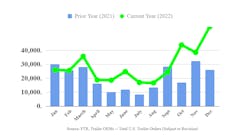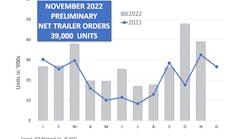Wading through truck and trailer production statistics is a tricky business. Who’s providing these numbers, are they sales quotes or actual orders, what trailers are we counting, so on and so forth. And above all else – what exactly do they mean?
Even a seasoned journalist like long-term Trailer/Body Builders editor Paul Schenck – who dedicated his entire career to covering trailer and truck body manufacturers – needed to conduct in-depth research to make sense of the annual sales figures, and several pages to explain their relevance to readers.
In other words, making actionable sense of gobs of figures requires the skills of a patient professional, and the considerable resources of a publication that takes pride in being the only magazine for people who produce and sell commercial truck bodies, trailers and truck equipment.
Fortunately, Trailer/Body Builders magazine, which has analyzed truck and trailer statistics for more than 60 years, is here to help. Our Truck-tistics archive, which dates to November 1975, preserves decades of production reporting by Schenck and others – much of it previously found only in print – making the information quick and easy to use for today’s manufacturing executives. (For current reports on production by the top 25 trailer manufacturers, refer to our Trailer Output Report)
Inception | Trailer production starts the long climb up again (pdf) November 1975
Statistical analyses of truck and trailer production didn’t originate in 1975, to be sure. Manufacturers, and their sales and marketing managers, have attempted to crunch the numbers, and create accurate forecasts for future production, since the first semi-truck was built more than 100 years ago.
But that year did give us the first “The Alcoa Forecast of Trends in the Truck Trailer Industry,” presented at the 1975 Truck Trailer Manufacturers Association board meeting by then-Alcoa Market analyst William Clingler, which spurred Trailer/Body Builders’ efforts to dive deeper into the available reports, including the one then produced by the US Department of Commerce’s Census Bureau, and form more accurate predictions about truck and trailers sales in the future.
Clingler, according to Schenck’s November 1975 story “Trailer Production Starts the Long Climb Up Again,” investigated dozens of market indicators while trying to determine which ones were most effectively correlated with truck trailer production, and which ones were most useful for predicting trends.
Alcoa’s formula was based on the Federal Reserve Board Production Index and the Fixed Investment Index, which is a measure of the nation’s total expenditures on structures, residential and non-residential, and equipment, such as trucks and trailers.
The company’s work was well-received by trailer manufacturers, so it offered to update its forecast annually, and Trailer/Body Builders vowed to ramp up its reporting by publishing much of the information monthly in a new statistical “Truck-tistics” review page starting in December, 1975, including Alcoa’s forecast, the Census Bureau’s truck trailer shipment report, the monthly truck tonnage report from the American Trucking Associations (ATA), and automobile manufacturer’s retail truck sales and stocks.
Infancy | Truck and trailer production increasing (pdf) December 1975
Trailer/Body Builders followed up on its promise to deliver improved forecasting in December 1975, drawing on truck production, the ATA’s intercity freight tonnage index and the leading indicators from the Alcoa Forecast to paint a more complete picture of where the trailer market was heading.
The new section, however, was not yet branded as Truck-tistics, instead going by the more mundane moniker “Industry Data.”
Initial iteration | Trailer production jumps 37% (pdf) January 1976
Truck-tistics, officially, is here.
The new section, using leading indicators to forecast trailer production, debuted in January, 1976, and continued to appear monthly in the pages of Trailer/Body Builders magazine for the next 25 years.
The first report noticed the successful use of ATA’s Index of Motor Freight Tonnage, the Federal Reserve Board Production Index and the Fixed Investment portion of the GNP, which accurately predicted an upward trend in trailer production, with shipments jumping sharply from September to October.
Annual inspection | 1976-2000
Trailer/Body Builders delivered its first annual review of yearly trailer production in March, 1976, looking back at a dismal 1975 in which the number of trailers built was slashed by more than half, year over year.
The roundup featured a breakdown of trailers produced by form—from complete “wheeled units” to container chassis, dollies and converter gear—and function, including van, reefer and tank trailers. It also included a summary of heavy-truck sales and brief look at the most recent leading indicators.
Compiled below are links to scans of the original annual reviews. Occasionally the preliminary figures released early in the year were revised. In those instances, a second article was published mid-year.
1975 Figures
72,000 trailers & chassis is total 1975 production (pdf) March 1976
Revised census figures show 5,000 more trailers in 1975 (pdf) July 1976
1976 Figures
Trailer production grows 50% in 1976 (pdf) March 1977
1977 Figures
Truck trailers up sharply in ’77 (pdf) March 1978
1978 Figures
Trailer shipments rise 23% in 1978 (pdf) March 1979
1979 Figures
Trailer manufacturers match best year ever (pdf) March 1980
1974 remains record for trailer shipments (pdf) July 1980
1980 Figures
Trailer shipments down 40% from 1979 (pdf) March 1981
Trailer shipments fall 40%; value decreases one-third (pdf) July 1981
1981 Figures
Trailer shipments lowest since 1976 (pdf) March 1982
1982 Figures
Trailer shipments fall 19% in 1982 (pdf) March 1983
1983 Figures
Trailer shipments increase 26% in 1983 (pdf) March 1984
1984 Figures
Trailer shipments shatter records throughout 1984 (pdf) March 1985
1985 Figures
Trailer shipments finish 18% below 1984’s record year (pdf) March 1986
1986 Figures
Manufacturers ship more than 170,000 trailers in 1986 (pdf) March 1987
1987 Figures
Trailer shipments in 1987: It was a very good year (pdf) February 1988
The final score: Manufacturers ship 180,142 complete trailers in 1987 (pdf) July 1988
1988 Figures
Trailer shipments top 176,000 in 1988 (pdf) February 1989
Census corrects trailer shipment data, bringing 1988 closer to a record year (pdf) November 1989
1989 Figures
Trailer shipments fall 9% during 1989 (pdf) February 1990
Census Bureau Revises 1989 Trailer Shipment Totals (pdf) October 1990
1990 Figures
Trailer shipments down 22% in 1990 (pdf) February 1991
1991 Figures
Trailer shipments up 11% in December (pdf) February 1992
It’s official—122,477 trailers built in 1991 (pdf) August 1992
1992 Figures
Trailer shipments highest since 1989 (pdf) February 1993
1993 Figures
1993 closes strong as trailer shipments reach nine-year high (pdf) February 1994
1994 Figures
Trailer Manufacturers shatter records in 1994 (pdf) February 1995
Census issues final count: 234,287 complete trailers built in 1994 (pdf) September 1995
1995 Figures
Trailer manufacturers break records in ‘95 (pdf) February 1996
Manufacturers shipped 279,144 trailers in 1995—up 19%—a $5.6-billion record (pdf) August 1996
1996 Figures
Early returns are in: Trailer industry posts third-best year in ‘96 (pdf) February 1997
Final score: 202,102 truck trailers in ‘96 (pdf) September 1997
1997 Figures
Strong shipments in December almost provide record year (pdf) February 1998
1998 Figures
The early returns: 344,017 trailers shipped last year (pdf) February 1999
1999 Figures (final year for Census Bureau Figures)
Trailer shipments up or down in 1999? (pdf) February 2000
For current production figures of the top 25 trailer manufacturers, visit the Trailer Output Report section of this site.










